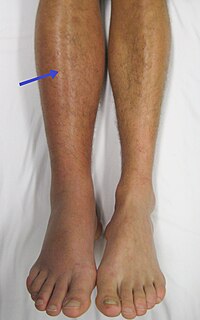
Photo from wikipedia
Whereas antiphospholipid syndrome (APS) is a non-inflammatory vasculopathy and is associated with thrombosis in 98% of cases, Behcet’s disease (BD) is a systemic vasculitis of unknown etiology, characterized by vascular… Click to show full abstract
Whereas antiphospholipid syndrome (APS) is a non-inflammatory vasculopathy and is associated with thrombosis in 98% of cases, Behcet’s disease (BD) is a systemic vasculitis of unknown etiology, characterized by vascular damage of any calibre. Both venous and arterial thromboses occur in 45% of BD patients and are associated not with hypercoagulable disease but with inflammatory changes in the vascular wall mediated by hypersecretion of pro-inflammatory cytokines and endothelial cells dysfunction. Thrombodynamics (TD) is a new global test for diagnosing plasma haemostasis disorders, identifying bleeding and thrombosis risks, and can be used to detect a prothrombotic state and assess the influence of disease activity and course on the hypercoagulation process.comparative assessment of TD in patients with APS and BD before anticoagulant therapy (AC).The study included 20 patients (9 APS and 11 BD) and 8 age and sex-matched healthy controls (HC). None of the subjects received AC. Thromboses in past history were registered in 5/9 (55%) APS patients and 2/11 (18%) BD patients and none of HC. Fetal loss occurred only in women with APS (4/4 (100%) who had pregnancy during the disease). All the patients were hospitalized and underwent fool investigation according to the diagnosis including TD, local coagulation tests and antiphospholipid antibodies profile.the velocity of clot growth in APS was lower, than in BD and in HC: 23.7 [22.6; 24.7] vs 29.0 [28.2; 34.4] and 31.1 [28.9; 33.5] Um/min, respectively (р=0.001). Clot size at 30 minutes in APS also was lower, than in BD and HC: 972.1 [921.3; 1007.4] vs 1152.7 [1098.3; 1225.4] and 1226.6 [1140.5; 1295.1] Um, respectively (р=0.001). Spontaneous clotting was registered only in 2 BD patients in mean time 2 minutes. Clot density and lag time (Tlag, the delay between the test start and the onset of clot formation) were the same in all three groups. Prolonged APTT was found in APS (33.7 [30.6; 47.1] sec) and normal APTT - in BD (30.9 [29.1; 31.1] sec) and HC (29.7 [28.2; 30.8] sec). Increased soluble fibrin-monomer complexes were revealed in all APS patients (100%), 91% BD patients and 25% HC (р=0.01). After interpretation the TD results were distributed as follows: hypocoagulation was noted in 1 APS patient with a positive lupus anticoagulant, while all other APS patients had normocoagulation. Thrombotic readiness status (TRS) was diagnosed only in 2 BD patients. The frequency of normocoagulation and hypercoagulation did not differ between BD and HC. Local coagulation tests (APTT, thrombin time, prothrombin time) were the same depending on hypo- and hypercoagulation by TD results. Fibrinogen level in BD patients with hypercoagulation was higher, than in BD patients with normocoagulation and TRS: 4.2 [3.6; 4.7] vs 2.8 [2.7; 3.0] and 2.8 [2.7;2.8] g/l respectively, р=0.04. BD activity by Behcet’s Disease Current Activity Form correlated with stationary velocity of clot growth (Rs = 0.68, p<0.05).Thrombodynamics results showed: before anticoagulant therapy there were normocoagulation with a tendency to hypocoagulation in APS and hypercoagulation in BD. In BD hypercoagulation associated with disease activity.None declared
Journal Title: Annals of the Rheumatic Diseases
Year Published: 2021
Link to full text (if available)
Share on Social Media: Sign Up to like & get
recommendations!